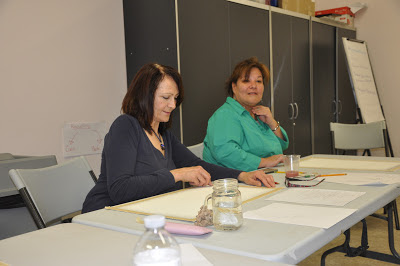Written by Jessica Geick, Gallery Assistant for Marketing and Online Relations
My interpretation of the Huron Tract Treaty of 1827
An image of buffalo remains that would be shipped to Europe to be used for fertilizer,
explosives and bone china.
Adrian then focused on the actual Treaty agreements, both pre and post-confederation, between the government and the Aborginal groups. I was surprised to learn that there were close to fifteen different treaties signed within the areas of Windsor, London, Niagara Falls and Sarnia. In all the British Crown signed over 14,000 treaties with native people around the world. We learned about the problematic nature of these documents since very few aboriginal leaders could understand the language and even with interpreters, many things were left unclear.
Adrian Stimson speaks about the Aborginal Treaty process in Canada
A recording of the Huron Tract Purchase Treaty of 1827 between the Chippewa and King George IV was played, and Adrian asked workshop participants to draw their interpretation of what the treaty meant and our feelings of what was being said. At times I felt that this task was a bit frustrating, as the language of this document was difficult to understand. I could only imaging how difficult it was for the Aboriginal people's to understand the definitions of this document at that time. The treaty laid out the geographical area that was given to the government in exchange for money, goods and agricultural equipment.
Participants were invited to speak about their treaty drawings and their interpretations of
what the recording of the treaty meant to them.
It was really interesting to hear people's interpretations of the document and what each of us got out of the recording. I believe this was a really worthwhile experience because it is important to really understand the history of the treaties, as they are the foundational documents of the relationship between native and non-native peoples, and they effect present day relationships and current events in Canada.
Adrian will be hosting the Herd Again workshop at the Sarnia Lambton Native Friendship Centre, located at 233 Lochiel St on Monday, May 13 from 5:00 pm to 7:00 pm. Everyone is invited to attend.
Adrian will be hosting the Herd Again workshop at the Sarnia Lambton Native Friendship Centre, located at 233 Lochiel St on Monday, May 13 from 5:00 pm to 7:00 pm. Everyone is invited to attend.

.jpg)



No comments:
Post a Comment